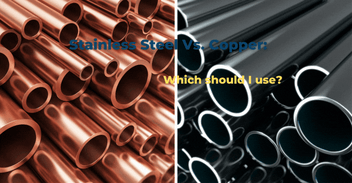What is Intergranular Corrosion (IGC)?
Some of us are familiar with situations where stainless-steel pipelines have corroded, or more specifically cracked, on the welds. But we didn’t know it had a name, let alone why it happened or how to avoid it.
Intergranular corrosion is called IGC for short and also known as ‘Intergranular Stress Corrosion Cracking’. It causes significant problems across industry yet isn’t given the attention it deserves.
So, why and how does it occur, and what are the solutions? Let’s put it under the microscope!
-2.jpeg?width=662&name=What%20is%20Intergranular%20Corrosion%20(IGC)-2.jpeg)
Like other common materials, metals have a visible grain structure when viewed under magnification. These grains are separated by grain boundaries. Intergranular corrosion is localised attack along the grain boundaries or immediately adjacent, while the bulk of the grains remain largely unaffected.
-3.jpeg?width=662&name=What%20is%20Intergranular%20Corrosion%20(IGC)-3.jpeg)
Figure 1: Microscope view of material attacked by IGC.
Before we jump into the cause of the issue, how does stainless achieve its corrosion resistance?
Chromium is added to stainless steel for the process of passivation, a mechanism by which an ultra-thin invisible film, known as passive film, forms on the surface. This passive film protects the metal from corrosion. The self-healing property of the passive film make the steel stainless.
Now for the breakdown on why IGC occurs.
The Three Zones in Welding:
-Oct-12-2021-02-30-29-73-AM.jpeg?width=411&name=What%20is%20Intergranular%20Corrosion%20(IGC)-Oct-12-2021-02-30-29-73-AM.jpeg)
Figure 2: The three zones of welding and the related confined area of high temperature.
-
The Unaffected Parent (Or Base) Metal:
The material being welded – at a relatively small distance from the weld it is only slightly warmed so that there is no change to its crystal structure, or to its properties. -
The Heat Affected Zone (Haz):
The area of the parent metal adjacent to the weld metal is heated through a range of higher temperatures up to the melting point, which occurs at the junction with the weld metal. The high temperatures reached induce changes to the crystal structure of the parent metal, which in turn may affect its mechanical, physical and corrosion resisting properties. -
The Solidified Weld Metal:
The composition of this can be either that of the parent metal or that resulting from a mixture of filler and parent metal. The solidified weld metal is a miniature “casting”. Its cast grain structure will differ from the parent metal.
Carbide Precipitation:
During welding, the HAZ is exposed to what is characterised as a sensitising temperature, between 426o and 760o C.
-4.jpeg?width=513&name=What%20is%20Intergranular%20Corrosion%20(IGC)-4.jpeg)
Figure 3
At this temperature, the alloy becomes particularly susceptible to precipitation of chromium carbides, which is when the chrome and carbon in the austenitic stainless steel are drawn out of the material. Carbon becomes a more desirable “partner” for chromium than oxygen. Thus, the chromium-oxides can break apart, and the freed-up chromium can link up with carbon to form a chromium-carbide.
Picture it in your mind as a “dance-team”, in which chromium and oxygen are dancing together on the dance floor. The carbon then comes over and taps oxygen on the shoulder and says, “Let me take over this dance”, then steps in, replacing oxygen in the dance-team, and now chromium and carbon are dancing together. These chromium-carbide teams, however, don’t stay on the dance floor, and instead, make their way off the floor, and out the doors, so to speak.
Sensitisation:
Going out the door is their going out into the grain-boundaries, resulting in the formation of chromium-depleted zones adjacent to the grain boundaries. This process is called sensitisation.
-1.jpeg?width=511&name=What%20is%20Intergranular%20Corrosion%20(IGC)-1.jpeg)
Figure 4: Grain boundaries marked in black.
Thus, with less and less chromium-oxide dance-teams on the dance floor, the result is loss of corrosion-resistance in the HAZ.
The resulting development of IGC cracking:
The grain interfaces of these sensitised alloys become very reactive due to their loss of corrosion resistance, and intergranular corrosion can result. IGC is characterised by a localised attack at and adjacent to grain boundaries (due to the low-chromium are as per Fig. 4) with relatively little corrosion of the grains themselves as they have retained their chromium. The alloy disintegrates (grains fall out) and/or loses its strength, resulting in the cracking.
As it is HAZ area around the weld which has become sensitised and very susceptible, the onset of corrosion or cracking is often termed ‘weld decay’, even though it isn’t exactly on the weld itself.
.jpeg?width=423&name=What%20is%20Intergranular%20Corrosion%20(IGC).jpeg)
Figure 5: Sensitisation within the HAZ, with associated formation of chrome carbides, and chromium depletion at the grain boundaries.
Under which operating circumstances does the cracking occur?
Corrosion rates are typically accelerated by high service temperatures, high concentrations of certain ions in electrolytes (especially chloride ions), and service situations that allow stagnant or very low-velocity electrolyte exposure to the metal. On stainless steels, attack is promoted by low-pH electrolytes. Such corrosion-promoting conditions may not be constant, but often occur because of process upsets.
-Oct-12-2021-02-30-29-92-AM.jpeg?width=442&name=What%20is%20Intergranular%20Corrosion%20(IGC)-Oct-12-2021-02-30-29-92-AM.jpeg)
Figure 6: Intergranular corrosion grain boundary attack and dropped grains.
In Layman's Terms:
During welding, the metal can form chrome-carbides adjacent to the weld. The formation of chrome-carbides depletes the metal of chromium. Without the chromium, the protective passive film cannot form, and corrosion can occur, particularly in situations where there’s high chlorine content (or salt), and especially with higher temperatures. This is called intergranular corrosion.
Some large Australian F&B engineers use press-fit only for hot water to eliminate welding and the chance for IGC to occur.
Salt plants are one example that regularly encounter IGC on hot water lines due to their high-salt environment, and Europress has been a solution as it eliminates welding and therefore doesn’t present the same issue.
Solutions:
-
If welding austenitic stainless, use a low carbon version such as 304L or preferably 316L. The "L" means that the carbon content of the alloy is below 0.03%, which prevents sensitization.
-
Precipitation of carbides occurs in the sensitisation range between 426 and 760°C, so keep the weld zone temperature below 426°C (practically impossible) or ensure rapid heating/cooling through the sensitization range, so that there is not enough time for the carbides to form.
-
Use an expensive ‘stabilised’ grade of stainless such as 2205, which has a duplex crystalline structure and doesn’t sensitise during welding.
-
The solution that will make your life easier and won’t leave your wallet in the featherweight category is to use Europress Stainless Steel Press-fit. Crimping the fittings does not expose the material to the sensitising temperature and therefore eliminates the potential for intergranular corrosion to occur. The only welds on Europress are those completed in the factory to create adapter fittings. You can check out Europress here.
-Oct-12-2021-02-30-30-07-AM.jpeg?width=667&name=What%20is%20Intergranular%20Corrosion%20(IGC)-Oct-12-2021-02-30-30-07-AM.jpeg)

-2.jpeg)
.png?width=352&name=WW%20%20Blog%20headers%202023%20(3).png)

